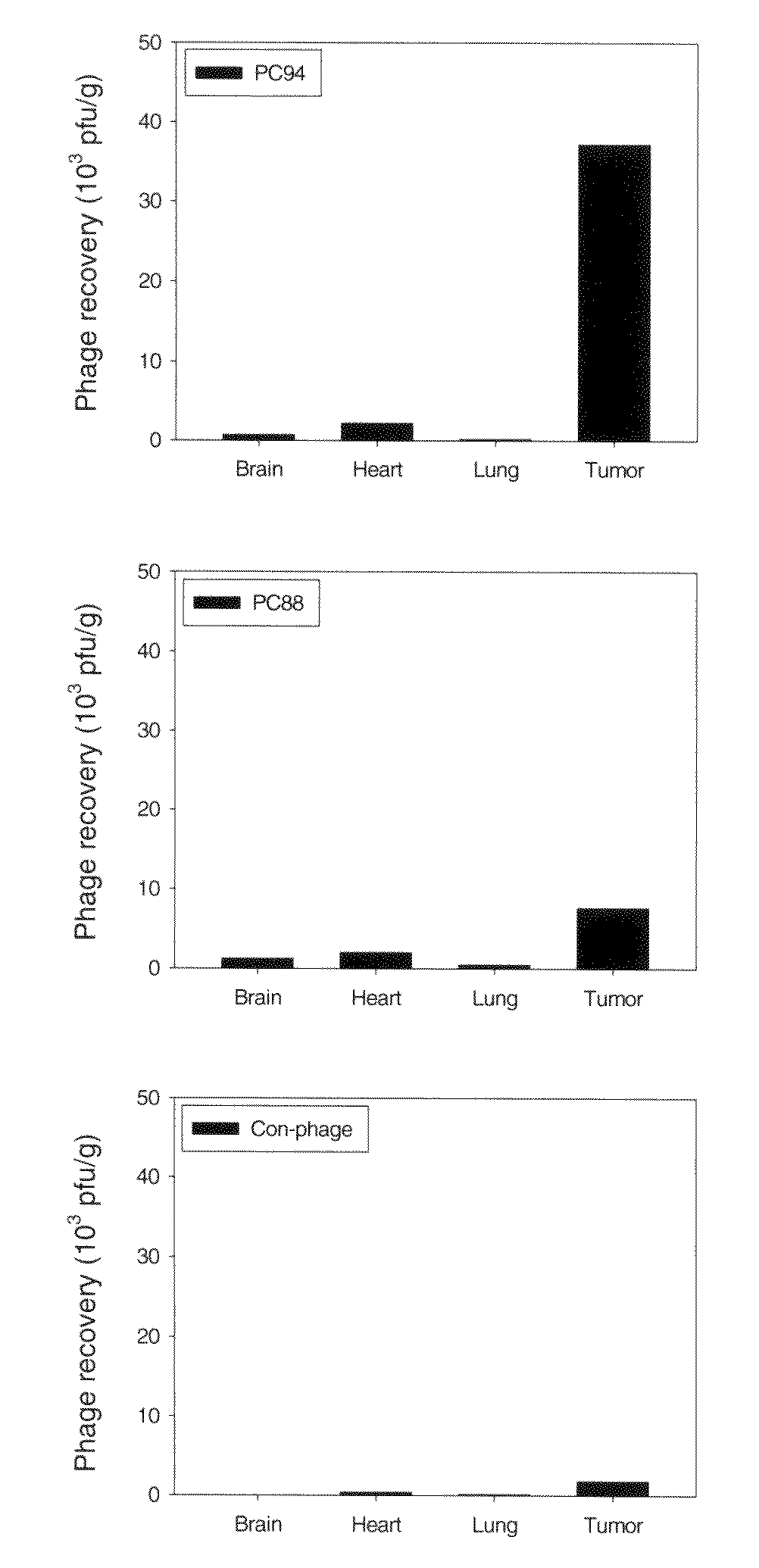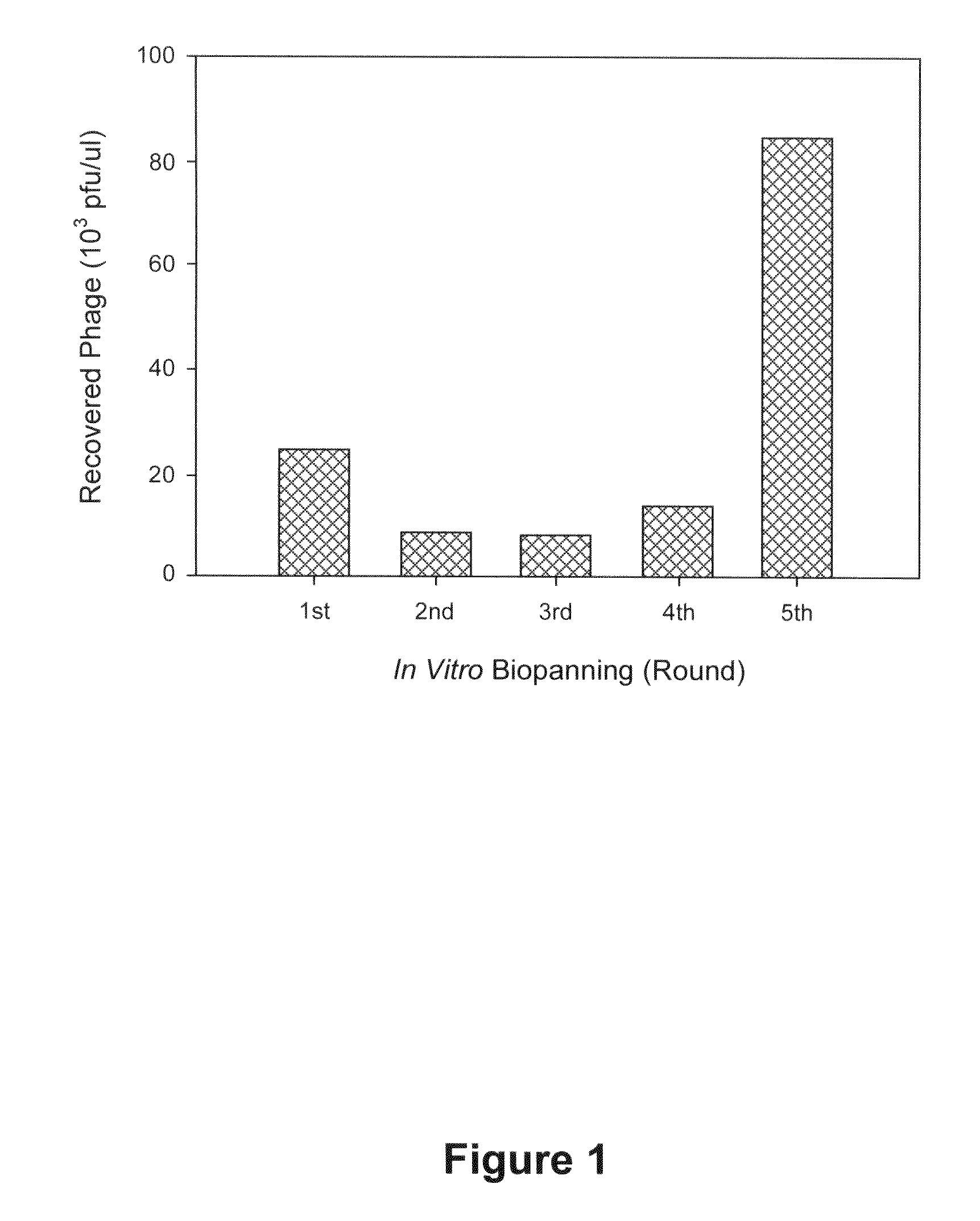Peptides specific for hepatocellular carcinoma cells and applications thereof
a hepatocellular carcinoma and peptide technology, applied in the field of peptides specific for hepatocellular carcinoma cells, can solve the problems of poor hcc prognosis, early disease relapse, incomplete tumor response,
- Summary
- Abstract
- Description
- Claims
- Application Information
AI Technical Summary
Benefits of technology
Problems solved by technology
Method used
Image
Examples
example 1
I. Example 1
Phage-Displayed Random Peptide Libraries and Biopanning
[0111]A. Cell Lines and Cell Culture
[0112]59T, Changliver, HA22T, Hep3B, HepG2, J5, NTUBL, Mahlavu and SKHepl, all human hepatocellular carcinoma lines, and NNM, human primary normal nasomucosal epithelia (8), were used. HCC cells were obtained courtesy of Dr. Hsiao M. (Genomic Research Center, Academia Sinica, Taiwan). All the human HCC cell lines and NNM were maintained in Dulbecco's modified Eagle's medium (DMEM) and 10% fetal bovine serum (FBS) at 37° C. in a humidified atmosphere of 5% or 10% CO2 in air.
[0113]Additional useful cell lines include, human lung squamous cell carcinoma line A549, high metastatic human lung adenocarcinoma line CL1-5, human lung adenocarcinoma line H23, human lung large cell carcinoma line H460, human lung cancer line PC13, human nasopharyngeal carcinoma line NPC-TW01, human oral squamous cell carcinoma line SAS, human pancreas carcinoma PaCa, colon (HCT116), breast (BT483), prostate (...
example 2
II. Example 2
Flow Cytometry and Biopsy Analyses
[0118]A. Identification of Phage Clones Specifically Binding to HCC Cells
[0119]To analyze the phage clones specifically binding to HCC cells, flow cytometry analysis was performed. HCC cells were grown to 70-80% confluence and harvested with 5 mM EDTA in PBS. HCC cells were resuspended in FACS buffer (PBS with 1% FBS) and incubated at 4° C. for 1 h with PC94 or control phage, which does not encode a protein, respectively. After washing with FACS buffer, HCC cells were incubated with monoclonal anti-M13 antibody at 4° C. for 1 h followed by 30 min incubation with anti-mouse antibody conjugated to R-phycoerythrin (Southern Biotech, Birmingham, Ala., USA). Analysis was performed on FACS-Calibur using CellQuest software (BD Bioscience, San Jose, Calif., USA).
[0120]The results revealed that phage clone 94 (PC94) had the best reactivity to HCC cells while the rest of the phage clones showed moderate binding activity to HCC cells (FIG. 2A). (A...
example 3
III. Example 3
Animal Model for In Vivo Targeting Assay and Peptide Competition Assay
[0128]Several issues were addressed to evaluate the potential of SP94, the polypeptide encoded by PC94, as a drug delivery director for targeted drug delivery against HCC. First, we investigated whether SP94 could be targeted to HCC cells in vivo. We examined the tumor homing ability of PC94 and its competitive inhibition by SP94 in a HCC xenograft model. In vivo homing experiments showed that PC94 has homing ability to tumor tissues, with a binding activity over 8-fold higher than that of the control phage (FIG. 3A). Moreover, in peptide competitive inhibition experiments, SP94 inhibited PC94 binding to the tumor mass, while the same concentration of a control peptide had no such inhibitory effect (FIG. 3B).
[0129]A. Animal Model for PC94 Targeting
[0130]To verify the targeting ability of PC94 in vivo, mice bearing Mahlavu-derived HCC xenografts (500 mm3) were injected with PC94 or control phage throu...
PUM
| Property | Measurement | Unit |
|---|---|---|
| Radioactivity | aaaaa | aaaaa |
| Chemotherapeutic properties | aaaaa | aaaaa |
Abstract
Description
Claims
Application Information
 Login to View More
Login to View More - R&D
- Intellectual Property
- Life Sciences
- Materials
- Tech Scout
- Unparalleled Data Quality
- Higher Quality Content
- 60% Fewer Hallucinations
Browse by: Latest US Patents, China's latest patents, Technical Efficacy Thesaurus, Application Domain, Technology Topic, Popular Technical Reports.
© 2025 PatSnap. All rights reserved.Legal|Privacy policy|Modern Slavery Act Transparency Statement|Sitemap|About US| Contact US: help@patsnap.com



